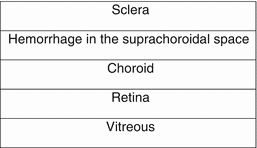and Mitrofanis Pavlidis2
(1)
Department of Ophthalmology, Uppsala University Hospital, Uppsala, Sweden
(2)
Augencentrum Köln, Cologne, Germany
Electronic supplementary material
The online version of this chapter (doi:10.1007/978-3-319-20236-5_24) contains supplementary material, which is available to authorized users.
Electronic supplementary material
for this chapter is accessible online at http://extras.springer.com/ by searching via the ISBN.
24.1 General Introduction
Video 24.1: Endophthalmitis and subchoroidal haemorrhage
Video 24.2: Open globe
Video 24.3: Globe rupture
The expulsive haemorrhage is a haemorrhage in the suprachoroidal space (Fig. 24.1). Sometimes the term “suprachoroidal” is used synonymously to “subchoroidal”. As a basic rule, these haemorrhages are removed from the scleral side, and not transretinal.


Fig. 24.1
Anatomy of a suprachoroidal haemorrhage
A choroidal detachment may have different causes. (1) It may arise after a cyclodestructive surgery with hypotony and choroidal detachment. In this case, the subchoroidal fluid consists of a transparent fluid. If you remove the fluid and inject silicone oil, you may lift the pressure to a normotensive level of 6–8 mmHg. (2) A different cause is a trauma with an open globe injury and suprachoroidal haemorrhage. (3) Another common cause is an intra- or postoperative suprachoroidal haemorrhage, for example, during a complicated cataract surgery or glaucoma surgery.
Wait about 1–2 weeks with the vitrectomy until the blood liquefies; always monitor for a retinal detachment that may develop which should be treated immediately. The surgery should be performed under general anaesthesia. Preoperative ultrasound is necessary to determine the shape and location of the choroidal haemorrhage. You have to perform a sclerotomy in the area of the highest choroidal detachment. We describe the surgical procedure of a suprachoroidal haemorrhage without expulsion of intraocular tissue.
Caution
It is highly recommended to use long trocars because the pars plana epithelium is detached. A detached pars plana epithelium will result in subepithelial-located trocars, subepithelial flow of the infusion and a choroidal detachment. Until now only 6 mm long trocars in 23G (Alcon) are available. If long trocars are available in 27G, it will be no problem to employ them instead.
24.2 Instruments
1.
23G 3-port trocar system with chandelier light
2.
BIOM
3.
Anterior chamber maintainer
4.
Vitreous cutter
5.
23G trauma trocars (6 mm, Alcon)
You need a retinal detachment set and a PPV set. The anterior chamber maintainer is an infusion cannula for the anterior chamber.
Surgical Pearls No. 87
An anterior chamber maintainer can be used for a vitrectomy instead of a pars plana infusion, if there is sufficient flow between anterior and posterior chamber, e.g. aphakia. It cannot be used in a phakic eye because there is no sufficient flow from the anterior to the posterior chamber.
24.3 Tamponade
PFCL, 1000 cSt silicone oil
24.4 The Surgery Step By Step
1.
Limbal peritomy.
2.
Place traction sutures beneath all four rectus muscles.
3.
Insert an anterior chamber maintainer.
4.
3 mm sclerotomies between insertion of the muscle and the equator.
5.
Drainage of suprachoroidal blood.
6.
Insertion of trocars
7.



